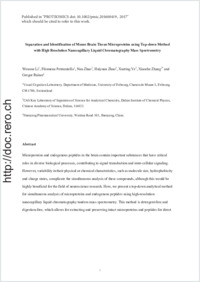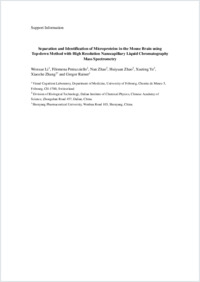Separation and identification of mouse brain tissue microproteins using top‐down method with high resolution nanocapillary liquid chromatography mass spectrometry
- Li, Wenxue Visual Cognition Laboratory, Department of Medicine, University of Fribourg, Switzerland
- Petruzziello, Filomena Visual Cognition Laboratory, Department of Medicine, University of Fribourg, Switzerland
- Zhao, Nan CAS Key Laboratory of Separation of Science for Analytical Chemistry, Dalian Institute of Chemical Physics, Chinese Academy of Science, Dalian, P. R. China
- Zhao, Huiyuan CAS Key Laboratory of Separation of Science for Analytical Chemistry, Dalian Institute of Chemical Physics, Chinese Academy of Science, Dalian, P. R. China
- Ye, Xueting Shenyang Pharmaceutical University, Shenyang, P. R. China
- Zhang, Xiaozhe CAS Key Laboratory of Separation of Science for Analytical Chemistry, Dalian Institute of Chemical Physics, Chinese Academy of Science, Dalian, P. R. China
- Rainer, Gregor Visual Cognition Laboratory, Department of Medicine, University of Fribourg, Switzerland
-
01.06.2017
Published in:
- PROTEOMICS. - 2017, vol. 17, no. 12, p. 1600419
English
Microproteins and endogenous peptides in the brain contain important substances that have critical roles in diverse biological processes, contributing to signal transduction and intercellular signaling. However, variability in their physical or chemical characteristics, such as molecule size, hydrophobicity, and charge states, complicate the simultaneous analysis of these compounds, although this would be highly beneficial for the field of neuroscience research. Here, we present a top-down analytical method for simultaneous analysis of microproteins and endogenous peptides using high- resolution nanocapillary LC-MS/MS. This method is detergent-free and digestion-free, which allows for extracting and preserving intact microproteins and peptides for direct LC-MS analysis. Both higher energy collision dissociation and electron-transfer dissociation fragmentations were used in the LC-MS analysis to increase the identification rate, and bioinformatics tools ProteinGoggle and PEAKS Studio software were utilized for database search. In total, we identified 471 microproteins containing 736 proteoforms, including brain-derived neurotrophic factor and a number of fibroblast growth factors. In addition, we identified 599 peptides containing 151 known or potential neuropeptides such as somatostatin-28 and neuropeptide Y. Our approach bridges the gap for the characterization of brain microproteins and peptides, which permits quantification of a diversity of signaling molecules for biomarker discovery or therapy diagnosis in the future.
- Faculty
- Faculté des sciences et de médecine
- Department
- Département de Médecine
- Language
-
- English
- Classification
- Biological sciences
- License
- License undefined
- Identifiers
-
- RERO DOC 288974
- DOI 10.1002/pmic.201600419
- Persistent URL
- https://folia.unifr.ch/unifr/documents/305688
Other files
Statistics
Document views: 99
File downloads:
- rai_sim.pdf: 130
- rai_sim_sm1.pdf: 101
- rai_sim_sm2.txt: 32
- rai_sim_sm3.txt: 58
- rai_sim_sm4.txt: 35


